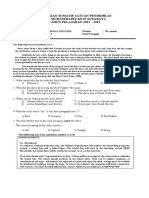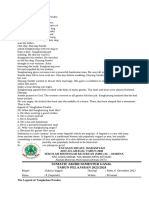Salar de Uyuni
Salar de Uyuni
Uploaded by
SUHENDRI, S.PdCopyright:
Available Formats
Salar de Uyuni
Salar de Uyuni
Uploaded by
SUHENDRI, S.PdOriginal Description:
Copyright
Available Formats
Share this document
Did you find this document useful?
Is this content inappropriate?
Copyright:
Available Formats
Salar de Uyuni
Salar de Uyuni
Uploaded by
SUHENDRI, S.PdCopyright:
Available Formats
Spreading out over 11,000-sq.-km, Salar de Uyuni is the largest salt flat in the world.
An
endless sheet of hexagonal tiles (created by the crystalline nature of the salt), dotted with pyramids
of salt, Bolivia’s salt flats are a dazzling display of nature’s magic.
Despite the desert dryness, freezing night temperatures, and fierce desert sun, this
landscape is not devoid of life. Pink flamingos, ancient cacti, and rare hummingbirds all live in the
Salar de Uyuni.
During the wet season, the salt desert is transformed into an enormous salt lake, albeit one
that is only six to twenty inches deep, traversable by both boat and truck. During this time, the
shallow salt lake perfectly mirrors the sky, creating bizarre illusions of infinity. In the middle of this
seemingly infinite salty lake is a hotel built entirely out of—naturally—salt.
Created from salt bricks held together with salt mortar, the hotel and everything inside it,
including the chairs and tables, are made from salt. While the Hotel Playa Blanca has no electricity
and little in the way of amenities (its water must be trucked in), it does offer even more important
and certainly rarer qualities: utter silence, an all-encompassing austere beauty, and an astonishing
view of the night sky.
Also worth traveling to are the nearby Laguna Colorado and Laguna Verde. Laguna Colorado
is a red-hued lake filled with thousands of pink flamingos, while Laguna Verde is a blue-green salt
lake found at the foot of the volcano Licancabur. Its shifting aqua color is caused by copper
sediments and microorganisms living within the lake.
1. What does the text concern about?
a. Salt flat
b. Salar de Uyuni
c. Bolivia flat
d. Nature’s magic
2. According to the text, we can know that .....
a. The salt dessert becomes an enormous salt lake during the dry season
b. Hotel Playa Blanca provides electricity and little in the way of amenities
c. We can find pink flamingos, ancient cacti and rare hummingbirds in Salar de Uyuni
d. Salar de Uyuni is not located in Bolivia
3. “it does offer even more.....” (Paragraph 4)
The word “it’ in the sentence refers to .........
a. The Hotel
b. The Amenities
c. The Hotel Playa Blanca
d. The salt
From a distance, Lake Hillier of Australia’s Recherche Archipelago looks like a swath of solid
bubble-gum pink. Draw closer, and the color takes on a more watery, translucent quality, but
remains unmistakably pink.
Whereas the causes behind the unusual coloring of other pink lakes, such as the nearby Pink
Lake and Senegal’s Lake Retba, have been definitively confirmed, the reason for Lake Hillier’s color
remains a mystery. Theories abound, of course.
Some speculate that Lake Hillier’s color, like that of the other lakes, is the result of high
salinity combined with the presence of a salt-loving algae species known as Dunaliella salina and
pink bacteria known as halobacteria. Unlike other pink lakes, however, which regularly change colors
in accordance with temperature fluctuations, Lake Hillier maintains its pink shade year-round. The
water even retains its rosy hue when bottled.
Whatever the cause, the water does not appear to pose any danger to humans. Swimming in
it is not possible anyway, since the island is used only for research purposes and tourists can admire
it only from above on helicopter rides.
4. What does the text highlight?
a. Australia
b. Recherche Archipelago
c. Lake Hillier
d. Bubble-gum pink
5. According to the text, we can know that .....
a. The scientist have known the causes behind the unusual coloring in Lake Hillier
b. The tourists are not able to admire Lake Hillier by helicopter
c. The colour of the water in lake Hillier is pink
d. The water of Lake Hillier is hazzardous for people.
6. “Swimming in it is not possible anyway.....” (Paragraph 4)
The word “it’ in the sentence refers to .........
a. The water
b. The Lake Hillier
c. The Human
d. The Island
Jigokudani Monkey Park is named because of the area’s eerie bubbling hot springs, harsh
landscape, and snowy frigid climate, Jigokudani translates to “Hell’s Valley”. Snow covers the ground
more than four months out of every year and the valley is lined with jagged cliffs, jutting over 2,500
feet into the air.
The park is most famous for its population of Japanese Macaques, also known as Snow
Monkeys, the most northern living non-human primates.
Sometime in the early ’60s these clever characters decided to test the waters of the natural
hot springs, and they’ve descended from the forest to warm up in their steamy discovery every
winter since. Some of the hot springs even reach temperatures above 122 degrees Fahrenheit, which
is perfect for warming monkeys along with visitors to the region.
Although not technically a religious site, the Snow Monkeys are popular in Japanese fables
and are believed to be messengers of the Shinto mountain gods and rivers. Although the region is
remote, there is no doubt that seeing monkeys on a spa retreat is probably a surreal and spiritual
experience all on its own.
7. What does the text discuss about?
a. Parks
b. Jigokudani Monkey
c. Hot springs
d. Jigokudani Monkey Park
8. Based on the text, we can know that .....
a. The Snow Monkeys are famous in Japanese fables
b. The snow covers Jigokudani monkey park less than four month out of every year
c. We can’t see Snow monkey near Jigokudani Monkey Park
d. The park is most famous for its population of human being
9. “The park is most famous for its population of Japanese Macaques.....” (Paragraph 2)
The word “its’ in the sentence refers to .........
a. The Monkey
b. The Jigokudani Monkey Park
c. The Human
d. The Population
There was a girl named Pina who lived on a fruit plantation with her mother. When her
mother worked night and day, little Pina spend all her time playing with her friends. When her
mother asked her to do something, she would always reply that she couldn't find things, even
if it was laying night in front of her eyes.
One day, her mother fell ill and couldn't even get up to cook some food. So, she asked
Pina to cook some rice. However, Pina being her lazy self, said "I can't find the pot. So where
should I put the rice?". Her mother told her where the pot was. Then she said, "Where is the
ladle, how am I going to cook without a ladle?" Again her sick mother had to tell her the exact
location. Pina did the same with salt, rice and water! Enraged by Pina's behaviour, her mother
curse " May you grow a thoussand eyes" and went back to sleep.
When she woke up, she could not find her daughter. She searched and searcehed and
so did every single person on plantation. When Pina's mother saw the fruit, she was
immediately reminded of Pina's beautiful brown eyes and thus, the fruit with a thousand eyes
was named " Pinya", meaning Pineapple in Tagalog.
1. What is the best tittle for the text above?
a. The fruit with thousand eyes
b. A lazy girl in plantation
c. The origin of pineapple
d. A missing girl
2. What happened to the mother when she realized Pina had gone?
a. She searched for her
b. She cursed her
c. She fell asleep
d. She got sick
3. What would happen if Pina was not lazy when she cooked the rice?
a. She would got a curse from her mother
b. She would become pineapple
c. Her mother would not curse her
d. Her mother would be angry with her
4. What can we learn from the story?
a. Don’t be lazy
b. Don’t spend you time for playing
c. Don not be angry to your child
d. Respect and obey your mother
Once upon a time,in Dumai, there was a prosperous Kindom named Seri Bunga
Tanjung. It was ruled by a beautiful queen whose name was Cik Sima. She had seven good
looking daughters. Out of seven, the youngest daughter, Mayang Mengurai, was the most
beautiful. Her beauty enchanted all taking a look at her.
One day, the seven princesses took bath in Sarang Umai pool, making joke and
remaining in the water for long time. While doing so, they were noticed by some guys. Those
were Prince Empang and his guardsmen who were passing by the pool. They peeped at the
seven princesses through shady bushes nearby the pool. The prince was amazed of seeing those
beautiful ladies, but his eyes could not stop watching the most beautiful, Princess Mayang Sari.
(Beautiful lady in Umai pool in Umai...ya..in Umai) mumbled Prince Empang Kuala.
Seemingly, the prince felt in love with Mayang Mengurai. He set his heart upon marrying her.
Few days later, The Prince Empang Kuala sent an envoy to the Seri Bunga Tanjung
Kingdom for proposing the beautiful princess (the youngest). Queen Cik Sima approved of the
proposal. However, instead of the youngest, it should be addressed to the oldest. Feeling
embarrassed, the Prince was angry and he ordered his commander and soldiers to attack Seri
Bunga Tanjung Kingdom.
During the war, Queen Ratu Cik Sima ordered his commander to take her seven
daughters to the jungle, hide them in the hole covered by trees. As their food supply, the queen
asked his to bring some food for three months supply. Three months passed, the war still broke
out. The war happened four months.
Many died during the war, Queen Cik Sima rushed for walking to the jungle where all
her daughters hid. Unfortunately, she was shocked after finding that all had died. They died of
thirsty and hunger.
Since then, Dumai society believed that name "Dumai" is rooted to a word "d" umai"
that was once said repeatedly by Prince Empang Kuala When seeing the beauty of Princess
Mayang Mengurai
1. The text tells us about .......
a. The Sarang Umay Pool
b. The origin of Dumai city
c. The Prince Empang Kuala
d. The Sri Bunga Tanjung KIngdom
2. Why did the prince attack Sri Bunga Tanjung Kingdom?
a. Because the oldest daughter accepted his proposal
b. Because the Queen Sima replaced to the oldest daughter
c. Because the princess Mayang Mengurai rejected his proposal
d. The prince Empang Kuala fell in love with Mayang Mengurai
3. What is the moral value of the text above?
a. Take care your children as well as possible
b. Never listen to someone’s advice
c. A prince must get everything what he wants
d. We are not allowed to force to get something
4. What would happen if Queen Cik Sima let prince got merried with her youngest
daughter?
a. The prince would be angry wiith her
b. The prince would destroy Sri Tanjung Kingdom
c. The prince would kill the queen sima
d. The prince would not attack the Sri Tanjung Kingdom
An old man named Takahama lived in a little house behind the cemetery of the temple
of Sozanji. He was extremely friendly and generally liked by his neighbors, though most of
them considered him little mad. That was because he was very old but he did want to get
married. He did not have the desire for intimate relationship with women.
One summer day he became very ill, so ill, in fact, that he sent sister–in-law and her
son. They both came and did all they could to bring comfort during his last hours. While
Takahama fell a sleep, they watched a large white butterfly flew into the room and rested on
the old man’s pillow. The young man tried to drive it away with a fan; but it came back three
times, as if was very loath to leave the sufferer.
At last Takahama’s nephew chased it out into the garden, through the gate, and into the
cemetery beyond, where it lingered over a woman’s tomb, and then mysteriously disappeared.
On examining the tomb the young man found the name “Akiko” written upon it, together with
a description narrating how Akiko died when she was eighteen. Though the tomb was covered
moss and must have been erected fifty years previously, the boy saw that it was surrounded
with flowers, and that the little water tank had been recently filled.
When the young man returned to the house he found that Takahama had passed a way,
and he returned to his mother and told her what he had seen in the cemetery. “Akiko?”
murmured his mother. “When your uncle was young he was betrothed to Akiko. She died
shortly before her wedding day. When Akiko left this world your uncle resolved never to marry,
and to live ever near her grave. For All these years he has remained faithful to his vow, and
kept in his heart all the sweetest memories of his one and only love.
Everyday Takahama went to the cemetery, whether the air was fragrant with summer
breeze or thick with falling snow. Everyday he went to her grave and prayed for her happiness,
swept the tomb and set flower there. When Takahama was dying, and he could no longer
perform his loving task, Akiko came for him. That white butterfly was her sweet and loving
soul.”
1. What is the topic of the text above?
a. An old man with his faith
b. An old man with his neighbours
c. A mad old man
d. A crazy old man
2. How was Takahama’s character?
a. He was humorous person
b. He was an indolent person
c. He was pathetic person
d. He was sociable person
3. Who was Akiko?
a. She was Takahama’s fiance
b. She was Takahama’s sister
c. She was Takahama’s niece
d. She was Takahama’s sister in law
4. From the text we can know that .......
a. Takahama didn’t visit Akiko’s cemetery everyday
b. Takahama got merried with another gild after Akiko passed away
c. Takahama didn’t love Akiko
d. Takahama was faithful person
One morning, there was a tiger who woke up and just felt great. He felt so good, he went out and
cornered a small monkey and roared at him. “Who is the mightiest of all the jungle animals?” The
poor little monkey replied, “You are of course, no one is mightier than you”.
A little while later, this tiger confronted a deer and bellowed out. “Who is the greatest
and strongest of all the jungle animals?” The deer was shaking so hard it almost could not speak, but
managed to say, “Oh great tiger, you are by far the mightiest animal in the jungle?”
The tiger walked proudly to an elephant that was quietly eating some weeds and roared
at the top his voice, “Who is the mightiest of all animals in the jungle?”
Then this elephant grabbed the tiger with his trunk, picked him up, slammed his down,
picked him up again and shook until the tiger was just a blur of orange and black. Finally, the
elephant threw him violently into a nearby tree. The tiger staggered to his feet and looked at the
elephant and said, “Man, just because you don’t know the answer, you don’t have to get so angry!”
1. What did the elephant do to the tiger with his trunk?
A. Grabbed him.
B. Answered his question.
C. Disturbed him.
D. Confronted him.
2. “ . . . pick him up again and shook . . . “ (paragraph 4).
The underlined word refers to . . . .
A. Elephant
B. Tiger
C. Monkey
D. Deer
3. What can we learn from the text?
A. We may not get easily angry to ourselves.
B. We may not be dishonest of ourselves.
C. We may not be silly of ourselves.
D. We may not be boastful
4. From the story above we know that . . . .
A. a tiger was the greatest and strongest animal
B. all of the animals were afraid of the tiger
C. the elephant was stronger than the tiger
D. the tiger was afraid of the elephant
You might also like
- ENT203 - Reading AssignmentDocument28 pagesENT203 - Reading AssignmentLe Nguyen Truc QuynhNo ratings yet
- Prediksi 2 BingDocument6 pagesPrediksi 2 Bingdryuen15No ratings yet
- English Test Preparation For Grade X FixedDocument7 pagesEnglish Test Preparation For Grade X Fixedangellatte31No ratings yet
- BASA PAG ASA Book 9 G6 FILIPINODocument10 pagesBASA PAG ASA Book 9 G6 FILIPINOIRENE BALENDRESNo ratings yet
- D. Orchard Road As Business and Entertainment CenterDocument9 pagesD. Orchard Road As Business and Entertainment CenterIqbale HimawanNo ratings yet
- English 4Document2 pagesEnglish 4maryforyou97No ratings yet
- Soal Am 13-15Document4 pagesSoal Am 13-15Nike MisrilestariNo ratings yet
- Soal Ulangan Harian Kelas 9Document10 pagesSoal Ulangan Harian Kelas 9Alfi HasanahNo ratings yet
- Legend, Myths and Folktales in Region 8: LengendsDocument3 pagesLegend, Myths and Folktales in Region 8: LengendsDarish Jane Bongan Cambalon100% (1)
- Traditional Costume in LuzonDocument14 pagesTraditional Costume in LuzonRozzete De JesusNo ratings yet
- Soal Ujian B.ing X FixDocument7 pagesSoal Ujian B.ing X FixFirman SyahNo ratings yet
- Soal PSSP 2023Document10 pagesSoal PSSP 2023ocidNo ratings yet
- ENT203 Reading AssignmentDocument28 pagesENT203 Reading AssignmentthuhyekyoNo ratings yet
- 35 Soal LatihanDocument11 pages35 Soal Latihanhikmahsalsabila49No ratings yet
- (WWW - Banksoal.web - Id) Soal Ujian Semester I SMA Kelas XI IPA-IPS - Bahasa InggrisDocument4 pages(WWW - Banksoal.web - Id) Soal Ujian Semester I SMA Kelas XI IPA-IPS - Bahasa InggrisYuanita Maya DamayantiNo ratings yet
- bu kisssDocument21 pagesbu kisssvandayatNo ratings yet
- English Test 5 Grade 5-Natural World-Irregulardoc_230607_163700Document3 pagesEnglish Test 5 Grade 5-Natural World-Irregulardoc_230607_163700syifaNo ratings yet
- Pas 9 English SoalDocument9 pagesPas 9 English SoalKharisma NarendraNo ratings yet
- Multiple ChoiceDocument7 pagesMultiple ChoiceAnisa salsabila AzlfNo ratings yet
- Appendices PDFDocument39 pagesAppendices PDFAnas TyasaNo ratings yet
- Latihan Soal UasDocument9 pagesLatihan Soal UasRehan123No ratings yet
- Drill 7 Text 1 For Questions 1 To 4: DescriptiveDocument14 pagesDrill 7 Text 1 For Questions 1 To 4: DescriptiveMarolinaNo ratings yet
- 12 Text SoalDocument9 pages12 Text SoalAufa HayatiNo ratings yet
- Narrative TextDocument16 pagesNarrative TextIra HerawatyNo ratings yet
- Genre BankDocument147 pagesGenre BankNonon SaribanonNo ratings yet
- PAS2Document8 pagesPAS2antonNo ratings yet
- Uh 1 Descriptive Text About PlacesDocument5 pagesUh 1 Descriptive Text About Placesakmal dzakwanNo ratings yet
- ENT203 Reading Assignment FinishedDocument28 pagesENT203 Reading Assignment FinishedTâm NguyễnNo ratings yet
- Ent203 Reading Assignment Reading Passage 1 1. San FranciscoDocument28 pagesEnt203 Reading Assignment Reading Passage 1 1. San FranciscoLe Ba Tam (K17 CT)No ratings yet
- Soal Latihan UN Paket1Document11 pagesSoal Latihan UN Paket1Anis MardiyatiNo ratings yet
- ENT203 Reading AssignmentDocument28 pagesENT203 Reading AssignmentVuong QuyenNo ratings yet
- Descriptive and Narrative TextDocument4 pagesDescriptive and Narrative TextRuslia Bunda JanitraNo ratings yet
- PTS Genap MTS 2023 Ing 9Document3 pagesPTS Genap MTS 2023 Ing 9Maratus SolehahNo ratings yet
- Bingg SMPMTSDocument7 pagesBingg SMPMTSdr. rennyNo ratings yet
- ENT203 - Reading AssignmnetDocument28 pagesENT203 - Reading AssignmnetNguyen Ngoc Lam (K17CT)No ratings yet
- Anis B Inggris Hal 36Document3 pagesAnis B Inggris Hal 36EdiputraNo ratings yet
- Descriptive TextDocument8 pagesDescriptive TextwirnaNo ratings yet
- Contoh Dan Soal Descriptive TextDocument9 pagesContoh Dan Soal Descriptive TextDreli Drem100% (1)
- The Monkey and the Crocodile: and Other Fables from the Jataka Tales of IndiaFrom EverandThe Monkey and the Crocodile: and Other Fables from the Jataka Tales of IndiaRating: 5 out of 5 stars5/5 (1)
- Descriptive TextDocument13 pagesDescriptive TextErvinna HutapeaNo ratings yet
- SOAL US SMA Kelas 12Document12 pagesSOAL US SMA Kelas 12Fathur RahmanNo ratings yet
- Soal Sas Ganjil Kelas IxDocument4 pagesSoal Sas Ganjil Kelas IxRisma ErniNo ratings yet
- This Following Text Is For Questions Number 1 To 5Document13 pagesThis Following Text Is For Questions Number 1 To 5Made SutamanNo ratings yet
- Soal Kelas XDocument3 pagesSoal Kelas XarlinNo ratings yet
- 0708 UAS Genap Bahasa Inggris Kelas 9Document6 pages0708 UAS Genap Bahasa Inggris Kelas 9Singgih Pramu Setyadi100% (12)
- Soal PasDocument3 pagesSoal PasAlmira 05No ratings yet
- Anahi ExamenDocument8 pagesAnahi ExamenÄnaHï KlkNo ratings yet
- Babbitt Jataka PreviewDocument23 pagesBabbitt Jataka Previewrajvipatel89No ratings yet
- Reading Materials For InnovationDocument26 pagesReading Materials For InnovationMavis Prejillana AllauiganNo ratings yet
- Exercise of Reading Comperehension (Latihan Reading)Document11 pagesExercise of Reading Comperehension (Latihan Reading)Tinut20% (1)
- IES For Pre-IntermediateDocument21 pagesIES For Pre-IntermediatevindesokhiralindaNo ratings yet
- Sugaring TimeDocument22 pagesSugaring TimeHoàng VinhNo ratings yet
- Most Famous and Amazing Places in ContinentalDocument8 pagesMost Famous and Amazing Places in ContinentalMuhammad ZainuddinNo ratings yet
- Panglao Island, Bohol - Unearthing The Mystical Hinagdanan CaveDocument9 pagesPanglao Island, Bohol - Unearthing The Mystical Hinagdanan CavesilcmtgNo ratings yet
- My Grandmother: Kelas 8 Description of The TigerDocument8 pagesMy Grandmother: Kelas 8 Description of The Tigeraviana arum kharismaNo ratings yet
- PAS INGGRIS GANJIL 2324 - Siswa-1Document11 pagesPAS INGGRIS GANJIL 2324 - Siswa-1sulthanjkjiNo ratings yet
- englishDocument24 pagesenglishSTEM-PERALTA RYZA M.No ratings yet
- Bing 10 Pas GenapDocument15 pagesBing 10 Pas Genapwahyu prasetiyoNo ratings yet
- Salar de UyuniDocument2 pagesSalar de UyuniMary Joy NievaNo ratings yet
- 7 Continents of The World: Facts About AsiaDocument12 pages7 Continents of The World: Facts About AsiaAsif MalikNo ratings yet
- Tran 2016Document9 pagesTran 2016raminNo ratings yet
- 11-024 DE FINAL Rev01 2014-03-14 PDFDocument273 pages11-024 DE FINAL Rev01 2014-03-14 PDFCarolina Helen Alanoca CamberosNo ratings yet
- 10 1016@j Gexplo 2018 02 013Document13 pages10 1016@j Gexplo 2018 02 013Ignacio DuranNo ratings yet
- Salar de UyuniDocument6 pagesSalar de UyuniANDREA MIKAELA OSINA PABONNo ratings yet
- Estudio Bolivia Plan-LitioDocument99 pagesEstudio Bolivia Plan-LitioJhonny Andres Orozco IriarteNo ratings yet
- Salar de Uyuni: Daniel Campos, Bolivia: Brine LithiumDocument3 pagesSalar de Uyuni: Daniel Campos, Bolivia: Brine LithiumRazvan Alexandru MateiNo ratings yet
- Bolivia Excursions and Holidays To BoliviaDocument2 pagesBolivia Excursions and Holidays To BoliviarussellxeeyuxogfxNo ratings yet
- Uyuni Salt FlatsDocument2 pagesUyuni Salt FlatsPaola Sherlyn ZegarraNo ratings yet
- Of Crystalsand Semiotic Slippage AQJuneaccepted 2023Document37 pagesOf Crystalsand Semiotic Slippage AQJuneaccepted 2023Felix PriceNo ratings yet
- 2 Do Trimester: 5 A-B Secundaria Carla Milenka Azurduy AngolaDocument7 pages2 Do Trimester: 5 A-B Secundaria Carla Milenka Azurduy AngolaSergio A. Machicado CastayaNo ratings yet
- Date-5821f2cd1658c1 16688373 PDFDocument2 pagesDate-5821f2cd1658c1 16688373 PDFaccessibleworke4No ratings yet
- Subject: WorkbookDocument19 pagesSubject: WorkbookCharlie WongNo ratings yet
- Soal Pat Kelas Xi Bahasa Inggris WajibDocument18 pagesSoal Pat Kelas Xi Bahasa Inggris WajibSuryana Syuaib, S.Pd., M.Pd.No ratings yet
- Latin America SoftDocument46 pagesLatin America SoftBryan RamosNo ratings yet
- Usbnsmp2018ing999 PDFDocument7 pagesUsbnsmp2018ing999 PDFwulannNo ratings yet
- Sol Gold Int Progress Test Unit 3A Answer KeyDocument2 pagesSol Gold Int Progress Test Unit 3A Answer KeyKATARZYNANo ratings yet
- Date-582088789ac073 95291640 PDFDocument2 pagesDate-582088789ac073 95291640 PDFlynncwcsezfuouNo ratings yet
- Student Book - Week 15Document6 pagesStudent Book - Week 15RakandNo ratings yet
- DK Strange But TrueDocument194 pagesDK Strange But TrueTanvir91% (11)
- Soal PAT GE XI SEM 2 22Document16 pagesSoal PAT GE XI SEM 2 22Nor AnnisaNo ratings yet
- Date-58211974ee0a09 06711553 PDFDocument3 pagesDate-58211974ee0a09 06711553 PDFaccessibleworke4No ratings yet
- Salar de UyuniDocument8 pagesSalar de UyuniSUHENDRI, S.PdNo ratings yet
- Personalized Excursions & Tour Packages in BoliviaDocument2 pagesPersonalized Excursions & Tour Packages in Boliviarebelreasoning828No ratings yet
- Allier Lithium Mine ProjectDocument4 pagesAllier Lithium Mine ProjectNo OneNo ratings yet
- Subject Link 4 - Translation Worksheet - PDFDocument32 pagesSubject Link 4 - Translation Worksheet - PDFsolsol0125No ratings yet
- Latihan UJian Sekolah - Share - EgDocument12 pagesLatihan UJian Sekolah - Share - EgChika AmaliaNo ratings yet
- Writing Unit 10Document1 pageWriting Unit 10Joquita Becerra SolizNo ratings yet
- Date-582230afbbb9e2 94404282 PDFDocument2 pagesDate-582230afbbb9e2 94404282 PDFrebelreasoning828No ratings yet

























































































